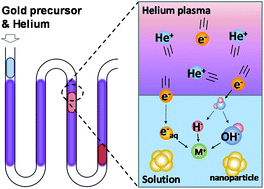Microfluidic chip for droplet-based AuNP synthesis with dielectric barrier discharge plasma and on-chip mercury ion detection†
Abstract
This study presents a novel microfluidic chip that can achieve on-demand gold nanoparticle (AuNP) synthesis using atmospheric pressure helium plasma and on-site mercury ion detection. Instead of using conventional chemical reaction methods, this chip uses helium plasma as the reducing agent to reduce gold ions and to synthesize AuNP, such that there is no residual reducing agent in the solution after removing the external electric field for plasma generation. The plasma discharge, gas–liquid separation, liquid collection and mercury ion detection can be achieved by this proposed microfluidic chip. The synthesized gold nanoparticles are further functionalized by 3-mercaptopropionic acid (3-MPA) for mercury ion detection. The 3-MPA-capped gold nanoparticles aggregate and result in a colour change of the solution due to the existence of Hg2+. The absorption spectra of the solution shifts from red to blue due to the cluster aggregation. The concentration of Hg2+ can be quantitatively determined by UV-Vis spectrometry, and the limit of detection was found to be 10−6 M (0.2 ppm). This developed integrated microfluidic device provides a simple and on-demand method for synthesis of AuNPs and Hg2+ detection in a single chip.



 Please wait while we load your content...
Please wait while we load your content...